
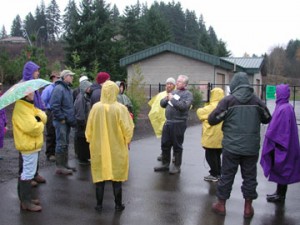
RNA Board Members, Rosemere residents, and concerned environmental activists gather in the rain to hear Thom McConathy explain the terrain and our community's failing stormwater and groundwater facilities.
On December 7, 2003, the RNA Board, accompanied by environmental activists, toured the Burnt Bridge Creek Basin and Vancouver Lake to learn more about the contamination of our waterways. This tour was lead by Thom McConathy, a very active community steward who has passionately fought to save our ground and surface waterbodies for more than 20 years. Mr. McConathy is among our community’s most knowledgeable experts on the subjects of water quality and contamination, and he has been instrumental in helping the RNA address the contamination of Burnt Bridge Creek and Vancouver Lake, as discussed in the RNA’s federal Title 6 complaint.
The hiking group assessed six different locations within the endangered watershed: The Andresen Pumping Station, Rufner Farm Pond, The Port of Vancouver Gateway Project, Vancouver Lake’s Flushing Channel, Vancouver Lake Park, and the end of Reigor Road at Shilapoo Lake.

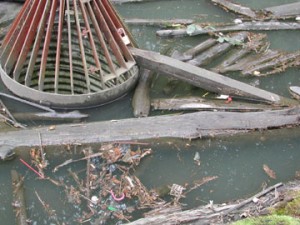
View of a storm sewer overflow pipe. This overflow, which feeds directly into Burnt Bridge Creek, is fed by pipes that rest under 'S' Street in the Rosemere
This overflow pipe collects stormwater from a large portion of Rosemere as well as from a large area of SR500. There has been indication that septic systems from some houses within the Burnt Bridge Creek watershed have been wrongly connected to the storm drains, and therefore, septic effluent can be and has been discharged directly into the creek’s flow. This can be further investigated by dye tests. Many septic systems in the Rosemere neighborhood failed dye tests in 1992, indicating that connections to the city sewer system may be compromised. Approximately 1/4 mile upstream from this overflow pipe, there are sewer inspection junctions in the middle of the creek flow, indicated by manhole covers. Sewer pressure can build and cause a geyser effect, shooting sewer waste up to 20 feet in the air, including discarded toilet paper, condoms and tampons that have been visible in the creek flow.
The RNA arranged for a local laboratory to test water samples taken from the stormwater pond pictured above (including the outflow of this pond into Burnt Bridge Creek). Test results showed greater than 2,400 E.-coli per 100mls (taken 9/16/03 and 9/17/03). Samples taken 10 years ago showed fecal coliform were over 3,000 org/100mls. The maximum contaminant level for human contact is 126 E.-coli according to EPA standards and 100 fecal coliform according to Washington Administrative Code. There is definitely fecal and E.- coli contamination of this pond. Microbial Source Tracking clearly shows that there is human waste present in this stormwater pond. The presence of human waste here indicates that failed septic tanks and cesspools are introducing septic effluent into the stormdrains in and around the Rosemere Neighborhood, and these stormdrains are carrying the human waste directly into Burnt Bridge Creek, which, in turn, befowls Vancouver Lake. This problem is happening throughout the Burnt Bridge Creek basin, among others. The measured contaminant level in the pondwater samples were more than 19 times the maximum for human contact, and measured contaminant levels of fecal coliform 30 times the maximum. The risks of human exposure to E.-coli (as well as typhus and hepatitis, among other pathogens) is very real.
The Natural Resources Defense Council has identified Vancouver Lake as a contaminated waterbody that is improperly monitored, and the adjacent public beachfront has been given the title of ‘beach bum,’ an area that is unsafe for public recreation due to increased environmental pollution. The contaminants in Vancouver Lake are noted by this council to be caused by failing septic tanks, overflow from sanitary sewer and waste management plants, and increased stormwater runoff due to a rapid development and increased number of impervious surfaces in the urban boundary.
The contamination of these waterbodies and the lack of adequate septic/sewer management and stormwater management programs are non-enforced violations of the federal Clean Water Act. The Clean Water Act requires that pollution of lakes, stream and rivers be controlled so these bodies of water are safe for swimming and fishing. Efforts must be stepped up to avoid systemic contamination of the area’s municipal drinking water supply, one third of which comes from the Burnt Bridge Creek Basin alone. There is concern that organic material from septic systems may be finding its way into the source of drinking water. Toxic byproducts are produced when organic material is introduced into chlorinated drinking water. Backflow relief valves are not being monitored and inspected within the effected areas. Failed backflow relief valves have been tied to contamination of municipal drinking water supplies, which may be in violation of the Safe Drinking Water Act.
A comprehensive system that accurately quantifies the number of homes currently relying on septic tanks is lacking in this geographic area. Real Estate documents pertaining to the sale of private properties have portrayed homes to be connected to city sewer service, when in fact the properties were only connected to a septic tank system. Years later, shocked homebuyers suffered costly repairs, the loss of household water use, the loss of potential real estate sales, lost sewer fees, lost wages, and health hazards when their unmanaged septic systems malfunctioned and soiled the property (both in and out of doors) with raw sewage. Negative dye tests performed in the early 1990’s by the city indicate that a large number of properties may not be connected to the city sewer, even though the owners think they might be properly connected. Records do not indicate the actions taken when negative dye tests were noted.
Septic tanks and cesspools do not operate very well in the Burnt Bridge Creek Basin due to the fact that the soil here is full of gravel and sand. Septic effluent moves very quickly through this kind of soil, especially where clay is directly beneath. The effect, therefore, is that septic effluent can (and does) easily migrate into surface water. The city of Troutdale, Oregon, which has the same type of soil as the Burnt Bridge Creek basin, grappled with the septic failure issues in the mid 1980’s. Troutdale performed an aggressive abatement of 25,000 septic systems in their basin in order to arrest the serious contaminant issue. The opinion has begun to surface among community leaders in Vancouver that it is time to place a moratorium on septic systems within the urban boundary, and to abate those that currently exist.

City Pumping Station Number 2 on Andresen Blvd. The drain fields surrounding this station cannot adequately handle the storm runoff from the shopping mall area. There is a high level of contamination in this stormwater resulting from motor oil and other engine lubricants that collect from impermeable surfaces like large parking lots. Septic effluent has also contaminated this area. Stormwater from this location drains into Burnt Bridge Creek, which adds to the contaminant levels of the creek flow.


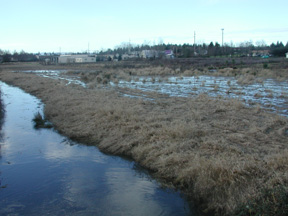
Drain fields surrounding City Pumping Station Number 2. Burnt Bridge Creek is seen at left in this photo. The stormwater at right in this photo comes from the Van Mall area. The drainage area does not sufficiently filter contaminants from the stormwater, and contaminated stormwater is entering Burnt Bridge Creek at this location.

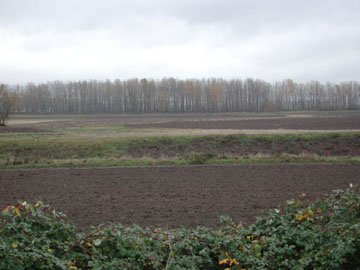
The proposed Gateway Project is located on the shore of the Columbia River, beside a defunct aluminum plant. Clark County, as management for this land, requires leasehold farmers to till under all crops in the fall, exposing raw soil to erosion. Farmlands should leave crop stubble during the winter to prevent such erosion. This tilling policy is used to prevent wildlife from being attracted to the area. Bald Eagles currently nest in these trees, and the developers simply plan to move the nest, which may be a violation of the Endangered Species Act. Many Great Blue Herons, Canadian Geese, White Tailed Hawks, pheasants, and other endangered and/or priority species live here too.
The proposed Gateway Project area is contaminated with fluoride, a byproduct of aluminum production from the nearby plant. This area is slated to become an industrial development, despite further risks to the Columbia River and non-compliance with the Shoreline Management Act and other master policies. The proposed Gateway Project site will have to be landfilled since it is below the 100 year flood plain. According to policy number 81of the Shoreline Master Program, “Speculative landfill activity should be prohibited.” The City, County and Port’s plans to develop this property without a specific leasee in mind is in direct violation of this policy. Development must be conducted through a contract with a specific leasee, and furthermore, the leasee must show that the development must be water related.
According to the Shoreline Management Master Program Policy, “Shoreline fills shall be designed and located so that there will be no significant damage to existing ecological systems or natural resources, and no alteration of local currents, surface water drainage of flood waters which would result in a hazard to adjacent life, property and natural resource systems…Further, the City of Vancouver should assess the overall value of the landfill site in its present state versus the proposed shoreline use to be created to ensure consistency with the Shoreline Management Act and this Master Program.” The RNA has submitted information to the City’s Planning Department that clearly shows the Gateway Project will violate set environmental policies.
Runoff from the proposed Gateway project could end up right in the flow of the Flushing Channel, which could dump even more concentrated pollutants into the already overwhelmed Vancouver Lake. There are also long-standing industrial pollution concerns taking place in the vicinity of the Gateway site, and baseline studies need to be performed to identify and remediate these polluting sources before additional industrial facilities are permitted. A garbage sorting company known as Columbia Resources has been suspect of causing pollution through the use of garbage barges on the Columbia River. This source of pollution can directly effect the shoreline of the Gateway project as well as the water quality of the Flushing Channel.
Any development of this property will result in stormwater outlets that will drain near the shoreline of the Columbia River. This development, which is contiguous with the Columbia River shoreline, creates an elevated potential for heavily concentrated pollutants to end up in the Columbia River due to the fact that near shoreline outlets cannot mix properly.


The Flushing Gate mechanism, as part of the operations of the Flushing Channel, which is currently malfunctioning.
This Flushing Gate allows contaminated water from the Columbia River to flow directly into Vancouver Lake. Fish that have been caught in this Flushing Channel have been found to contain toxic elements that exceed 10 of 11 of the EPA’s toxic substance thresholds, including heavy metals, pesticides, dioxins, phisteria, benzene carcinogens, and chlorinated biphenals (solvents). These waters are used by endangered species of Salmon, and these fish are being poisoned.
The Port of Vancouver is seeking to re-dredge the Flushing Channel since a lack of proper management has allowed the channel and the lake to become blocked with year’s of accumulated sediment. Re-dredging this flushing channel will only make the water quality of Vancouver Lake worse with the introduction of heavily contaminated water. The lake is near death already resulting from toxic buildup. The operation of this Flushing Gate creates the capillary effect, wherein tidal influences cause Salmon Creek and Lake River to flow backwards, thus dumping high levels of contamination from Salmon Creek and Lake River back into Vancouver Lake. The Salmon Creek Basin is also inundated with contaminants from failed septic tanks.
An attempt was made from 1978-1982 to rehabilitate Vancouver Lake. This project, including the design and implementation of the Flushing Channel, cost the taxpayers more than $17 million. The Environmental Protection Agency provided half of this cost in a special grant from the Clean Lake Fund, a predecessor to the Superfund program.
According to stipulations from the EPA Grant (as found in the approved “208″ plan) the Port of Vancouver (or its designated maintenance contract personnel) were required to perform scheduled maintenance and inspections of the Flushing Channel equipment. The scheduled maintenance included work on the following equipment:
1. Flap gate, sheaves, winch and brackets
2. Sluice gate, stem, gear pedestal lift and brackets
3. Ladder, platform and railings
4. Concrete gate well structure and grating
5. 84 inch diameter pipe and air vents
6. Concrete headwalls, trash racks and rip-rap
7. Fencing, guard rails and culverts
8. Roads, ditches, pads and embankments
There are no maintenance files available for the listed equipment above, and the creation of a maintenance file for each piece of equipment was required. Scheduled reports on this work were also to be kept, but none can be found. The working parts of the Flushing Channel were inconsistently maintained until about 1998 when a Port Employee made an arbitrary decision to simply stop doing the scheduled maintenance because it was “too much of a hassle” to acquire the necessary permits to do the work. This arbitrary decision did not involve the Port Directors and did not represent set policy, yet it added to the many failures of the Flushing Channel. Resulting from this failure, the Port of Vancouver is now seeking a fast-paced permit to re-dredge the flushing channel since it is now nearly completely blocked with sediment and it is malfunctioning. This is simply throwing good money after bad as indicated by the fact that the design of the Flushing Channel did not work in the first place.
Most importantly, maintenance was required to regularly clean the eleven sediment cells that were created as part of the continued operation of the Flushing Channel, and careful records were to be kept to track the layers of sediment collected and water quality measurements were to be maintained during the many years of operation of the channel. Only one sediment cell was ever inspected, and none of them were ever cleaned or maintained, thus they eventually plugged up. Water quality tests were performed through Burnt Bridge Creek Utility Funds, but this minimum amount of testing stopped in about 1990 when the city vacated this utility program. What little testing was left was performed by the Department of Ecology, and that completely stopped in about 1995. The lack of required maintenance files, the lack of maintenance of the sediment cells, the lack of water quality monitoring, and the lack of implemented groundwater protection plans (also required as part of the approved “208″ plan) are all violations of the terms and conditions of the EPA’s Clean Lake Award.
All of these oversights were a direct cause of buildup of pollutants and contaminants in Vancouver Lake, along with a lack of required maintenance and cleanup of Burnt Bridge Creek, including failed septic systems in the Burnt Bridge Creek Basin. All of these facts add up to violations of the Clean Water Act as the contamination is being introduced into the Columbia River. Flushing the contaminant from Vancouver Lake into the Columbia River (which feeds into the Pacific Ocean) would result in the dumping of hazardous materials into a marine environment, a habitat for various priority species covered under the Endangered Species Act. Therefore, flushing Vancouver Lake could result in a Violation of the Safe Harbor Act.
No jurisdiction has claimed responsibility for Vancouver Lake itself. The Port of Vancouver is responsible for the Flushing Channel only. The Port has made no claim to Vancouver Lake thus far, other than the Lake’s rehabilitation project from 1978-1982, funded (in part) by a Clean Lake Award from the EPA. Thus, there is insufficient baseline data from either the Port of Vancouver, The City of Vancouver, or Clark County to determine that there is no significant adverse impact resulting from the Flushing Channel’s operation (pouring the flow of the Columbia and Willamette Rivers into Vancouver Lake.) There has been insufficient water quality testing of any of these waterbodies in order to substantiate a claim of determination of nonsignificance relative to this project. The net result therefore, is a lack of consistency of environmental study of impacts from any of the aforementioned jurisdictions. Before a permit is approved to re-dredge the Flushing Channel, there should be an interjurisdictional and interlocal agreement to study the environmental impacts of the Flushing Channel on the surrounding waters. The interlocal agreement should bring the Port of Vancouver, the City of Vancouver, and Clark County together to allow for the best science to be applied as well as the best water quality management practices. Without such an agreement, there will be a complete lack of consistency in dealing with the myriad of environmental contaminant issues that arise with this proposed project. A formal watershed council should also be formed in order for all interested stakeholders to participate in the problem-solving process as committed stewards of the community. The contamination of these various waterbodies precludes any single jurisdiction’s ability find resolution to the contaminant issues.
Furthermore, there has been no baseline studies of significant outfalls from local industry that directly effect the water quality of the Columbia/Willamette flows and the Flushing Channel, or the Lake. Nor have baseline studies been performed to identify the effects of stormwater outfalls into these same waterbodies, nor have there been baseline studies to determine the adverse effects of nearby wastewater treatment facilities that contribute to the contamination in like fashion. The operation of the Flushing Channel has a direct effect upon the flows of Salmon Creek, Burnt Bridge Creek, and Lake River, and there is insufficient baseline study to determine the amount of contamination added to the lake via these waterbodies. There are far too many unknown variables that contribute to the eutrophication of Vancouver Lake, and the operation of the Flushing Channel only worsens the water quality of the Lake. Spending funds to re-dredge the Flushing Channel without all of the baseline data referenced above will have a zero net effect of positive gain, and it will, literally, only serve to flush more money down the drain.


Thom McConathy inspects soil quality on the water rim of Vancouver Lake. Soil samples taken from under the water line show iron deposits, magnese nodules, a lack of root structure and a foul odor associated with sulphur cycle conditions inherent in hydric soils. There are other areas within this watershed where hydric soil samples are contaminated with oil and rubber residues, indicated by a heavy black or blue color, and a rubbery or sulphur dioxide odor.
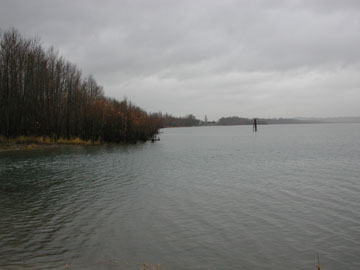
The shoreline of Vancouver Lake adjacent to the Flushing Channel, where contaminated water from the Columbia River flows directly into the wading waters of the public's Vancouver Lake Beach.

The Columbia River water at this location is fed by the Willamette River, which is a federal Superfund site due to extreme contamination. The influences of the Willamette can be seen in aerial photographs that indicate how the Willamette’s water does not immediately mix with the Columbia’s flow. The Willamette water can be seen as a separate stream line of tremendous force within the Columbia’s flow (even far downstream from the Flushing Channel). The ultra fine sediments from the Willamette are unique to that watershed, and they are present in the sediments deposited in and around the Flushing Channel as well as within Vancouver Lake. This is a clear indicator that the Willamette’s water flows directly into the Flushing Channel, and therefore, directly into Vancouver Lake, carrying toxic contaminants with it. There are no such ultra fine sediments found in the Columbia’s flow upstream of the Flushing Channel. Prior to the installation of the Alcoa Aluminum Plant, the Willamette used to flow through the Alcoa site and directly into Vancouver Lake and Lake River. At present, the Willamette flows into the channel at the shores of the Alcoa site, upsteam of the Flushing Channel. Additional contaminants enter Vancouver Lake via Burnt Bridge Creek, Salmon Creek, and the many outfalls from stormwater sources throughout the shoreline of the lake.


Sign posted at Vancouver Lake Beach Park that reads: '1991 -- Health Officials advise the public not to drink Vancouver Lake water, & to bathe after wading. Please don't wade if you have any of the following: diarrhea, open soars or wounds, infections of the skin, ears, throat or eyes, infants should wear plastic pants.'
The RNA is seeking to establish a community-based, interjurisdictional watershed council to address these many serious water quality issues. Our ground, surface and drinking water are all at risk. The RNA has applied for a Collaborative Problem-Solving Grant through the Environmental Protection Agency to help achieve water quality improvement, and finalists for this national grant program will be announced by January 31, 2004. Governor Gary Locke has formally endorsed the RNA’s grant application, and he has committed his staff to participate in the collaborative process. The RNA has also received memorandums of agreement from various federal, state and local jurisdictions, as well as private organizations that all wish to support and participate in the collaborative problem-solving process. Together, we can all work to solve our water quality problems, and our work can be used as a model to aid other community’s throughout the country.
REVISED 12/30/03










![Washington State Water Quality Assessment [303(d)] Washington State Department of Ecology](http://www.rosemerena.org/home/wp-content/uploads/2009/03/ecy_logo.gif)

